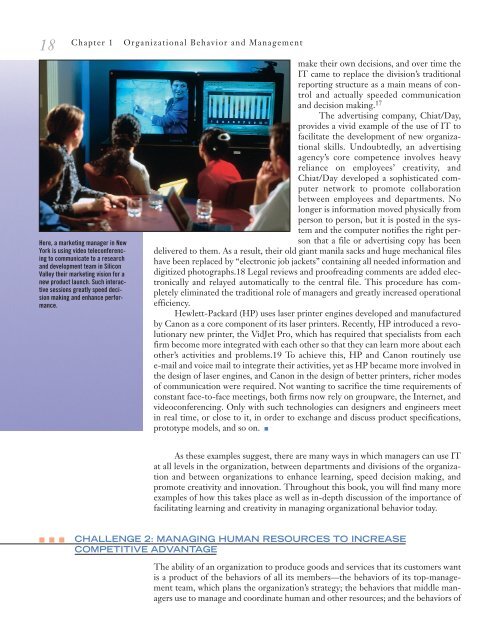chapter - Pearson
chapter - Pearson
chapter - Pearson
Create successful ePaper yourself
Turn your PDF publications into a flip-book with our unique Google optimized e-Paper software.
18<br />
Chapter 1 Organizational Behavior and Management<br />
Here, a marketing manager in New<br />
York is using video teleconferencing<br />
to communicate to a research<br />
and development team in Silicon<br />
Valley their marketing vision for a<br />
new product launch. Such interactive<br />
sessions greatly speed decision<br />
making and enhance performance.<br />
make their own decisions, and over time the<br />
IT came to replace the division’s traditional<br />
reporting structure as a main means of control<br />
and actually speeded communication<br />
and decision making. 17<br />
The advertising company, Chiat/Day,<br />
provides a vivid example of the use of IT to<br />
facilitate the development of new organizational<br />
skills. Undoubtedly, an advertising<br />
agency’s core competence involves heavy<br />
reliance on employees’ creativity, and<br />
Chiat/Day developed a sophisticated computer<br />
network to promote collaboration<br />
between employees and departments. No<br />
longer is information moved physically from<br />
person to person, but it is posted in the system<br />
and the computer notifies the right person<br />
that a file or advertising copy has been<br />
delivered to them. As a result, their old giant manila sacks and huge mechanical files<br />
have been replaced by “electronic job jackets” containing all needed information and<br />
digitized photographs.18 Legal reviews and proofreading comments are added electronically<br />
and relayed automatically to the central file. This procedure has completely<br />
eliminated the traditional role of managers and greatly increased operational<br />
efficiency.<br />
Hewlett-Packard (HP) uses laser printer engines developed and manufactured<br />
by Canon as a core component of its laser printers. Recently, HP introduced a revolutionary<br />
new printer, the VidJet Pro, which has required that specialists from each<br />
firm become more integrated with each other so that they can learn more about each<br />
other’s activities and problems.19 To achieve this, HP and Canon routinely use<br />
e-mail and voice mail to integrate their activities, yet as HP became more involved in<br />
the design of laser engines, and Canon in the design of better printers, richer modes<br />
of communication were required. Not wanting to sacrifice the time requirements of<br />
constant face-to-face meetings, both firms now rely on groupware, the Internet, and<br />
videoconferencing. Only with such technologies can designers and engineers meet<br />
in real time, or close to it, in order to exchange and discuss product specifications,<br />
prototype models, and so on. ■<br />
As these examples suggest, there are many ways in which managers can use IT<br />
at all levels in the organization, between departments and divisions of the organization<br />
and between organizations to enhance learning, speed decision making, and<br />
promote creativity and innovation. Throughout this book, you will find many more<br />
examples of how this takes place as well as in-depth discussion of the importance of<br />
facilitating learning and creativity in managing organizational behavior today.<br />
■ ■ ■<br />
CHALLENGE 2: MANAGING HUMAN RESOURCES TO INCREASE<br />
COMPETITIVE ADVANTAGE<br />
The ability of an organization to produce goods and services that its customers want<br />
is a product of the behaviors of all its members—the behaviors of its top-management<br />
team, which plans the organization’s strategy; the behaviors that middle managers<br />
use to manage and coordinate human and other resources; and the behaviors of

















